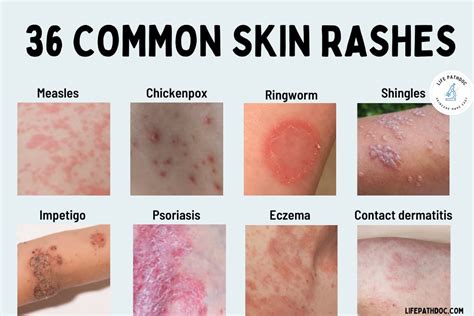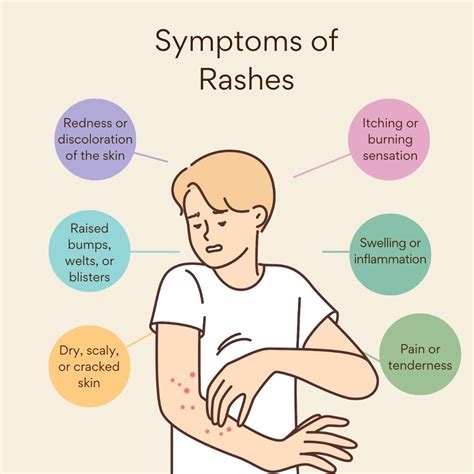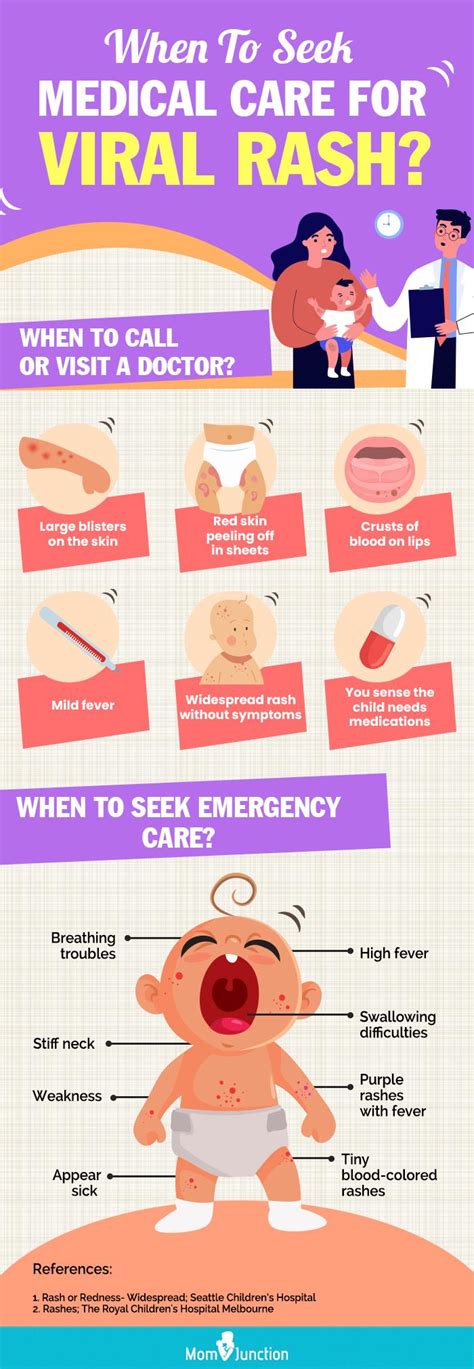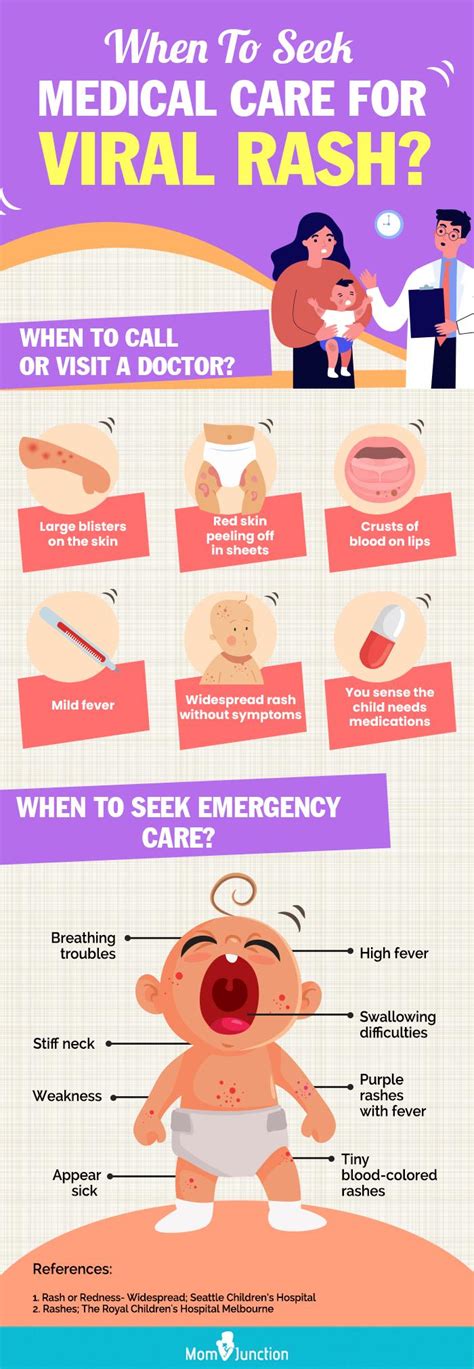Intro
Identify viral rash symptoms with 5 common appearances, including skin eruptions, blisters, and itchy patches, and learn about contagious rashes, rash treatment, and prevention methods to manage outbreaks and alleviate discomfort.
The appearance of a viral rash can be a concerning and uncomfortable experience for individuals of all ages. Viral rashes are a common symptom of many viral infections, and they can manifest in various ways, depending on the underlying cause. In this article, we will delve into the different ways a viral rash can appear, exploring the characteristics, symptoms, and potential causes of these rashes.
Viral rashes can be caused by a wide range of viruses, including herpes simplex, varicella-zoster, and enteroviruses. When a virus infects the body, it can trigger an immune response, leading to the appearance of a rash. The rash can be a sign that the body is fighting off the infection, and it can also be a way for the virus to spread to other parts of the body. Understanding the different ways a viral rash can appear can help individuals identify the potential cause and seek medical attention if necessary.
The appearance of a viral rash can vary greatly, depending on the underlying cause. Some viral rashes may appear as small, flat spots, while others may be raised, blister-like lesions. The color, shape, and size of the rash can also provide clues about the underlying cause. In some cases, the rash may be accompanied by other symptoms, such as fever, headache, and fatigue. By recognizing the different ways a viral rash can appear, individuals can take steps to manage their symptoms and prevent the spread of the infection.
Types of Viral Rashes

There are several types of viral rashes, each with distinct characteristics and symptoms. Some of the most common types of viral rashes include:
- Maculopapular rash: This type of rash is characterized by small, flat spots that may be red or pink in color. Maculopapular rashes are often seen in individuals with viral infections such as measles, rubella, and roseola.
- Vesicular rash: This type of rash is characterized by small, blister-like lesions that may be filled with fluid. Vesicular rashes are often seen in individuals with viral infections such as herpes simplex and varicella-zoster.
- Petechial rash: This type of rash is characterized by small, pinpoint spots that may be red or purple in color. Petechial rashes are often seen in individuals with viral infections such as enterovirus and adenovirus.
- Morbilliform rash: This type of rash is characterized by a flat, red rash that may be accompanied by fever and other symptoms. Morbilliform rashes are often seen in individuals with viral infections such as measles and rubella.
Causes of Viral Rashes

Viral rashes can be caused by a wide range of viruses, including:
- Herpes simplex: This virus can cause a range of symptoms, including cold sores, genital herpes, and encephalitis.
- Varicella-zoster: This virus can cause chickenpox and shingles, both of which can result in a viral rash.
- Enteroviruses: These viruses can cause a range of symptoms, including fever, headache, and rash.
- Adenoviruses: These viruses can cause a range of symptoms, including fever, headache, and rash.
Symptoms of Viral Rashes

The symptoms of a viral rash can vary greatly, depending on the underlying cause. Some common symptoms of viral rashes include:
- Redness and inflammation: The affected area may become red, swollen, and inflamed.
- Itching and burning: The affected area may itch or burn, especially if the rash is caused by a viral infection such as herpes simplex.
- Blistering: The affected area may develop blisters or vesicles, especially if the rash is caused by a viral infection such as varicella-zoster.
- Fever: A viral rash may be accompanied by a fever, especially if the underlying cause is a viral infection such as enterovirus or adenovirus.
Treatment and Management of Viral Rashes

The treatment and management of a viral rash depend on the underlying cause. In some cases, antiviral medications may be prescribed to help manage symptoms and prevent complications. In other cases, supportive care such as rest, hydration, and pain management may be necessary. It is essential to seek medical attention if the rash is severe, widespread, or accompanied by other symptoms such as fever, headache, and fatigue.
Prevention of Viral Rashes

Preventing the spread of viral rashes requires good hygiene practices, such as:
- Washing hands frequently with soap and water
- Avoiding close contact with individuals who have a viral rash
- Avoiding sharing personal items such as towels and utensils
- Getting vaccinated against viral infections such as varicella-zoster and herpes simplex
Additional Tips for Prevention
Additional tips for preventing the spread of viral rashes include: * Keeping the affected area clean and dry * Applying topical creams or ointments to help manage symptoms * Avoiding scratching or rubbing the affected area * Getting plenty of rest and staying hydratedWhat are the most common causes of viral rashes?
+The most common causes of viral rashes include herpes simplex, varicella-zoster, enteroviruses, and adenoviruses.
How can I prevent the spread of viral rashes?
+Preventing the spread of viral rashes requires good hygiene practices, such as washing hands frequently, avoiding close contact with individuals who have a viral rash, and avoiding sharing personal items.
What are the symptoms of a viral rash?
+The symptoms of a viral rash can vary greatly, depending on the underlying cause, but common symptoms include redness and inflammation, itching and burning, blistering, and fever.
In summary, viral rashes can appear in various ways, depending on the underlying cause. Understanding the different types of viral rashes, their causes, symptoms, and treatment options can help individuals manage their symptoms and prevent the spread of the infection. By practicing good hygiene, getting vaccinated, and seeking medical attention when necessary, individuals can reduce their risk of developing a viral rash. We invite you to share your thoughts and experiences with viral rashes in the comments section below, and to share this article with others who may be interested in learning more about this topic.
